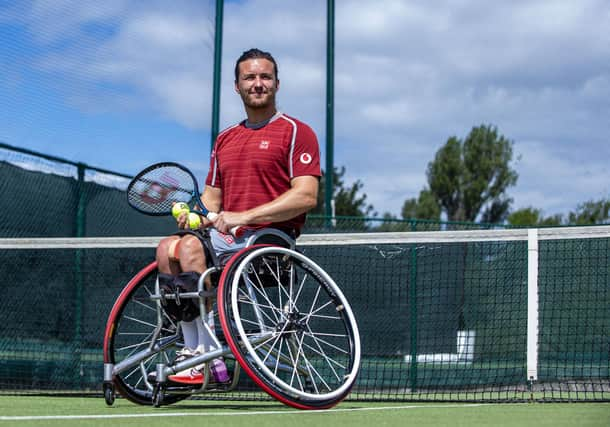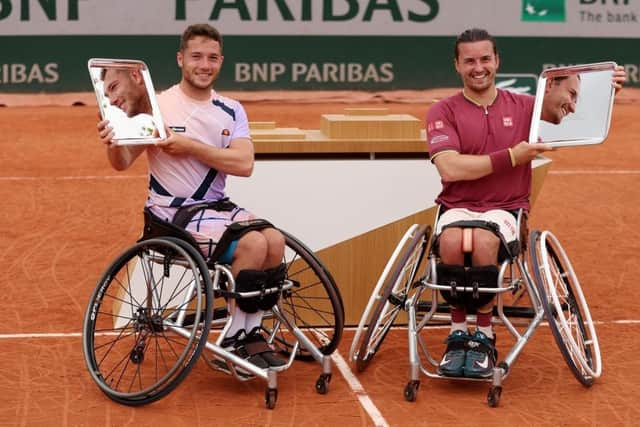How Gordon Reid recovered from his darkest moment to become our greatest tennis charioteer: 'My friends saved me'


Our greatest tennis charioteer has been dodging the rain all day. Nothing new in that for a Scot, of course, but Reid lugged his wheelchair from his Glasgow home only to be turned away from sodden Edinburgh grass courts. Forced to practice for Wimbledon on a synthetic surface, he walks out of the changing-rooms with the help of AFOs - ankle foot orthoses which stabilise the lower joints on his legs - and greets me with a beaming smile.
It takes a lot more than summer showers to get this man down. Last year was a jolt in what’s been a glittering career, torn tendons in his playing arm causing him to wonder if he might have to quit for good. “I’ve one less muscle in my left wrist now so have had to build the others to compensate.” Then he smiles again. “Maybe this’ll qualify me for a couple of games of a start. I shall be writing to be authorities!”
Advertisement
Hide AdAdvertisement
Hide AdReid, 31, laughs often. When I congratulate him on the OBE awarded him in the King’s Birthday Honours to add to the MBE six years ago, this Rangers fanatic says he wants to find out when Ibrox legend John Greig is collecting his gong so they might travel down to Buck House together.


In the course of our hour together, the rain still falling, there are funny, heartwarming stories about the posse - the friends from schooldays who follow his exploits at Slams and Paralympics around the world, urging him on with shouts of “Reido! Reido”. These guys were there for Reid when just before his 13th birthday he was struck down with a rare spinal condition. As he recalls his darkest moment, the twinges in my knee have completely disappeared.
In Helensburgh his parents, accountant Graham and Alison, along with Reid’s siblings Emily, Stephen and David, formed a tennis family. Reid played all the time at the local club, hitting a ball off a wall if he couldn’t find an opponent, but in September 2004 the dream was to be a footballer. “I was left-back for Ardencaple Boys’ Club - not left back in the changing-room, as the old joke goes - and desperately wanted to be spotted by Rangers. This day me and some pals had been playing in the park. We’d gone back to my house for some juice and a chill-out. I went to stand up and my legs just buckled underneath me. At first we all thought this was hilarious. My friends tried to get me to run along the corridor upstairs and I was bouncing off the walls. It was all a joke. We were heading back to the park although the others needed to support me, arms round shoulders. Mum saw this and shouted us back.
“I spent the rest of the day lying on the couch. Our doctor thought it was probably just cramp. He recommended hot and cold on the back of my legs. But then I started getting these pains. I couldn’t move my legs anymore.”
Tests were conducted at Glasgow’s Southern General Hospital. Lumbar punctures and MRI before Reid was found to be suffering from transverse myelitis. “I was told I might never walk again. My memory of that time isn’t great. I know some folk make a thing of the day of a horrible diagnosis - to celebrate that they’re still alive - but I don’t know mine. Everything was so scary for me and everyone else.
“I was six months in the hospital, Mum sleeping in a camp bed next to me having given up her job at a nursery school, which was tough for my sisters and brothers. She got a break when my pals came to visit and I’ll never stop thanking them enough for being there for me.
“Every day after school they’d travel by train to the hospital - a 45-minute journey - and keep my spirits up with board games and daft stories. They also brought homework for me, which was less of a treat. Because I was in hospital so long I was kind of cut off from the reality of my situation and didn’t appreciate how much my life would change.
“Everything changed. Our house had to be reconfigured. But the school [Hermitage Academy] was brilliant and my friends continued being brilliant. They carried my bag for me and pushed my wheelchair between classes. I was allowed to leave lessons five minutes early so there was always a scramble between them to be my helper.
Advertisement
Hide AdAdvertisement
Hide Ad“I’m still very close to lots of them and still have special feelings for those I don’t see as much now. They all kept me going and what I would have done without them, I don’t know.” He namechecks a few: “Craig Scott, who’s in the RAF, came out to Rio [2016 Paralympics, gold for our man] with Mikey Donald. Two weeks on the Copacabana, they were there for longer than me. Mikey used to be in the Army and lives down south so he manages along to every Wimbledon. Craig’s never been but will be there this year.
“And Gary Peak, who’s a personal trainer, was living in Australia in 2016 so he saw me win my first Grand Slam singles title. That was special because he’d been there when I collapsed and stayed with me the whole rest of the day.”
The same year Reid followed Melbourne with victory in Wimbledon’s inaugural wheelchair singles and ended it No 1 in the world. He has a complete set of Paralympic medals and a share of no less than 21 Slam doubles successes. Needless to say, back in 2004 he envisaged none of this.
“I thought my sporting life was over. Basketball, when I didn’t have any mobility in the chair, was beyond me. I went along to a session but the coaches wouldn’t let me on the court, saying it was too dangerous. Then my parents suggested wheelchair tennis. I didn’t know there was such a thing.
“There was a club in Scotstoun. I still struggled to move the chair, and couldn’t reach shots just a foot either side of me, but hitting balls again was brilliant. When I’m asked to tell my story I tend to brush over a lot of stuff because it’s difficult to get across how hard that time was. I suffered depression, the lowest of the lows. That probably took years to overcome. But tennis was huge in helping me and three guys at that club in particular - Kev Simpson, Ryan McDonald and Peter Moore, who’s since sadly passed away. Without their friendship and support, I wouldn’t have been able to keep going. The impact they’ve had on my career has been massive.”
Reid’s first tennis idol was Roger Federer, eventually replaced by Andy Murray. “He’s been an absolute inspiration, a big reason I’m where I am today, showing that coming from Scotland you can do it. In 2013 [Murray’s first Wimbledon title] a couple of names were pulled out of the hat among the wheelchair players and I was lucky enough to see him make history.
“Andy’s always been brilliant with us, always knowledgeable and interested. When we meet up he doesn’t talk about himself but asks questions about our matches. In 2016, after we’d both won gold in Rio, he staged an exhibition match [at Glasgow’s Hydro] and I got to replace his brother Jamie and play doubles with him. I was a nervous wreck but it was one of the highlights of my career. If he needs a partner again, I’ll be there.”
Reid is fascinated to see how Murray performs in SW19. “To come back from injury, setback, being written off and proving he can play five sets with a metal hip has been amazing and testament to character and fighting spirit. Last year, when I wondered if I might not be able to play again, Andy’s story kept me going.”
Advertisement
Hide AdAdvertisement
Hide AdReid still has much he wants to achieve. He aims to be going for gold again in next year’s Paralympics in Paris, and at Los Angeles 2028. He’d love to bring a major wheelchair tournament to Scotland and has begun the conversation with the sport’s governing bodies. And with his regular doubles partner Alfie Hewett edging ahead in title successes he insists he’s not yet finished with winning Slams.
The pair have done much to up the profile of their version of tennis, not least in the exciting matches they provided on Wimbledon’s No 1 Court last year after the lucky break of Rafael Nadal’s injury opening up space in the big arenas. Now for Centre.
“That’s the dream to increase the profile and encourage others,” he says. “We want to be integrated with able-bodied tennis and achieved that in 2022 by chance. At the US Open, Roland-Garros and in Melbourne, wheelchair tennis has happened on the Centre Court. That’s more of an issue at Wimbledon because of the chairs potentially damaging the surface. But we’ve got Jamie Baker, a former Scottish player who’s now tournament director there, and he’s a big ally for us. Maybe the solution would be to have our doubles final as the very last match. If we churn up the grass the greenkeeper would have plenty of time to repair it. And if that meant waiting until ten o’clock at night on that closing Sunday, I’d definitely be there.”
Comments
Want to join the conversation? Please or to comment on this article.